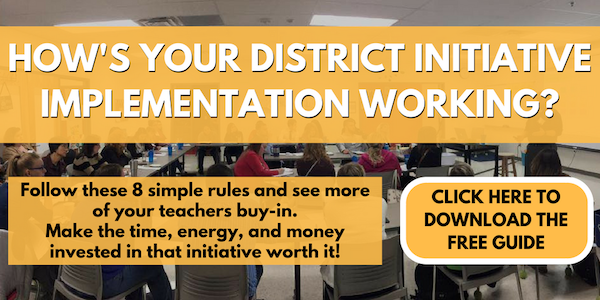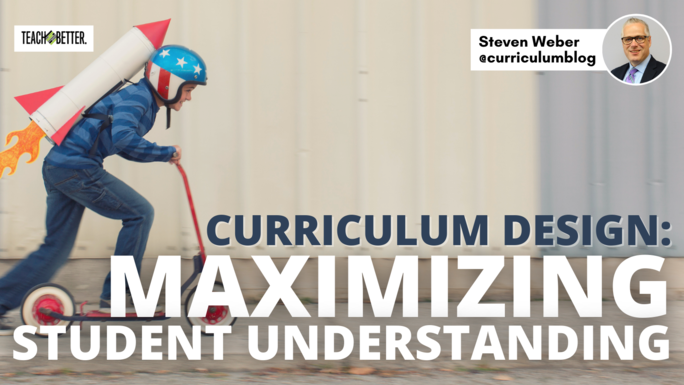TL;DR:
- Curriculum design teams should begin with the end in mind.
- Empower curriculum design teams by providing time for them to become crystal clear about the standards before debating essential skills, key concepts, content, or assignments.
- When a district team identifies transfer goals, it will support teachers across schools.
- Formative assessments will support decisions about teaching and learning.
- Make sure to align the curriculum to the district’s goals.
“One of the tasks of curriculum leadership is to use the right methods to bring the written, the taught, the supported, and the tested curriculums into closer alignment, so that the learned curriculum is maximized.”
– Allan Glatthorn
Curriculum design is complex.
One would assume that a classroom teacher or a curriculum director is an expert at designing curriculum to support teaching and learning. When teachers from multiple schools are designing a district curriculum, the task becomes more difficult.
Each professional brings their favorite lessons, unit template, and experiences to the table. According to Fenwick English (2000), “Curriculum is any document that exists in a school that defines the work of teachers by identifying the content to be taught and the methods to be used” (p.2).
Instructional leadership involves having a clear understanding of the district’s goals. In the absence of district goals, instruction and assessment will lack direction and purpose. Wiggins (1997) wrote, “with clarity about the purpose of content in the intended performance results, teachers and students will be able to grasp and better adjust in light of their priorities from day one” (p. 57).
According to Hale (2008), curriculum development is “an ongoing process that asks teachers and administrators to think, act, and meet differently to improve their students’ learning” (p. 8). Instructional leadership involves collaboration across schools, a district vision, communication, reflection, specific learning goals, and a method for measuring student understanding.
Empower curriculum design teams by providing them time to become crystal clear about the standards before debating essential skills, key concepts, content, or assignments. Click To Tweet6 Key Considerations for Curriculum Design Teams
Begin with the End in Mind
What is the “end in mind” for your grade level or course? Too often, teachers and district administrators begin planning by designing Lesson 1 or Unit 1. If a school district wishes to develop a K-12 Writing Plan, it is wise to begin with focusing on the type of products students will be required to write in their senior year.
Backwards map until you get to developing writers in kindergarten. “When school staff have a more informed conception of curriculum, a teacher’s daily decisions about how to deliver instruction not only affect student achievement in that classroom but also future student achievement, for it is assumed that students will be entering the next classroom prepared to handle a more sophisticated or more expansive level of work” (Zmuda, Kuklis & Kline, 2004, p. 122).
Wiggins and McTighe emphasized the need for backwards design in Understanding by Design (1998). Before you begin purchasing textbooks, identifying online resources, and writing Unit 1, identify the learning targets and desired outcomes. Students will benefit from increased clarity on the essential learning outcomes.
Unpack the Standards
When state standards are adopted, teacher teams can unpack the standards or follow documents that have been created by the state department of education. While it is beneficial to have documents created for teachers, I believe it is more beneficial when teachers have conversations about the standards and do the heavy-lifting of unpacking.
Ainsworth wrote, “If teachers aren’t crystal clear about the full and precise intent of a given standard, how can they accurately teach it? How can they accurately assess student understanding of it? How can they clearly communicate to students the specific learning intentions for a unit of study? Answer: Without first analyzing the standard, they can’t” (2015). Empower curriculum design teams by providing them time to become crystal clear about the standards before debating essential skills, key concepts, content, or assignments.
Identify Transfer Goals
How often do we design teaching and learning for transfer? According to Grant Wiggins (2013), “Transfer is the bottom-line goal of all learning, not scripted behavior. Transfer means that a learner can draw upon and apply from all of what was learned, as the situation warrants, not just do one move at a time in response to a prompt.”
It is critical to design for transfer. When educators focus on transfer they will design authentic tasks for students. When a district team identifies transfer goals, it will support teachers across schools.
Teaching does not need to follow a script. When individual teachers design lessons and units, they can align their assignments to the district’s transfer goals. If the goal is important, then it should be communicated and transparent.
Design Formative Assessments
Formative assessments should not be optional. If student understanding is the goal, then formative assessments will support decisions about teaching and learning. Some school districts have a curriculum and instruction department and an assessment department.
Unfortunately, the two departments work in isolation. “Formative assessment, done well, represents one of the most powerful instructional tools available to a teacher or a school for promoting student achievement” (Stiggins & DuFour, 2009, p. 640).
Align the Curriculum to the District’s Goals
Too often, teachers develop curriculum and instruction in isolation. Students receive a disjointed curriculum when each teacher or school determines the curriculum priorities. Teacher autonomy is critically important. A ‘canned curriculum’ rarely supports teaching and learning. The classroom teacher knows the strengths and weaknesses of each learner and should be able to personalize learning for each student.
Unpacking the standards adds clarity, but each school district has goals that should be communicated through a website or district document. If a school board seeks students who graduate college and career ready, then the term ‘college and career ready’ must be unpacked. Each teacher should be able to explain how their lesson plans or unit plans align with the district’s goals.
[scroll down to keep reading]
Implement the Curriculum
Implementation may seem obvious. However, implementation is one of the most difficult steps in curriculum design. Instructional leaders cannot send an email to teachers and hope they implement a well-designed plan.
One of the barriers to implementation is the lack of an implementation plan. Leaders spend so much time and energy on curriculum design that they announce the plan and fail to implement it. When your school district develops curriculum, it is important to begin with the end in mind.
In this case, beginning with the end in mind is determining how the curriculum will be implemented and reviewed prior to designing the curriculum.
About Steven Weber
Dr. Steven Weber is the Associate Superintendent for Teaching and Learning with Fayetteville Public Schools (AR). His areas of research include curriculum design, formative assessment, professional learning, and school leadership.



